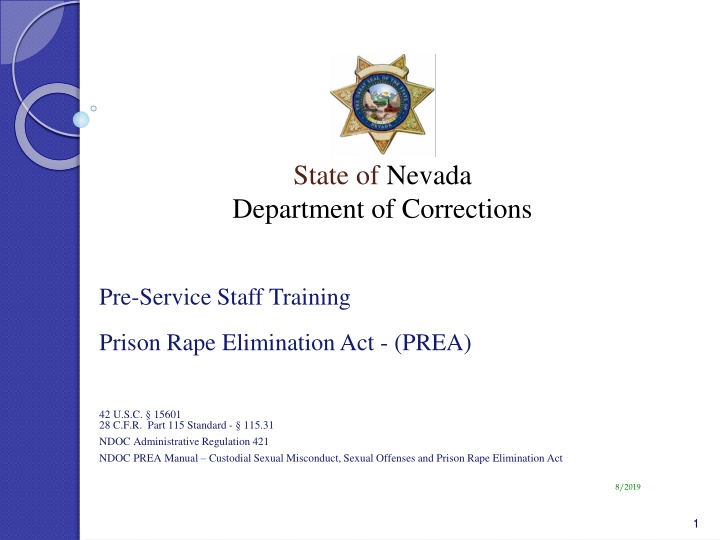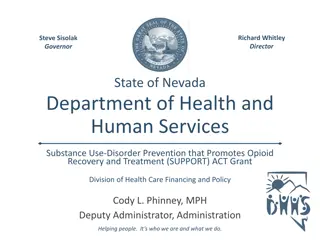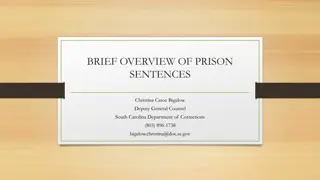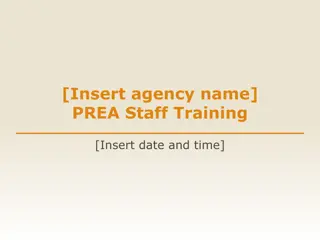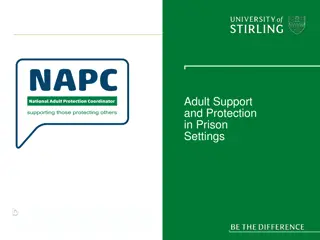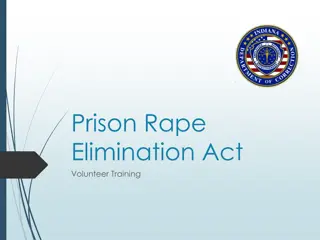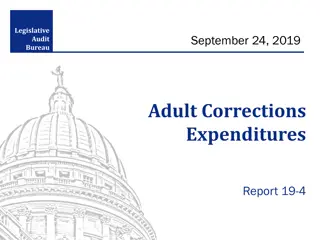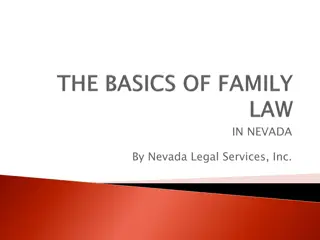Nevada Department of Corrections Pre-Service Staff Training on Prison Rape Elimination Act (PREA)
This training program covers the Prison Rape Elimination Act (PREA) and aims to educate staff on zero tolerance policies, responsibilities in preventing sexual abuse/harassment, inmate rights, dynamics of abuse, and compliance with laws. It also provides an overview of PREA, its significance, and who it applies to.
Download Presentation

Please find below an Image/Link to download the presentation.
The content on the website is provided AS IS for your information and personal use only. It may not be sold, licensed, or shared on other websites without obtaining consent from the author.If you encounter any issues during the download, it is possible that the publisher has removed the file from their server.
You are allowed to download the files provided on this website for personal or commercial use, subject to the condition that they are used lawfully. All files are the property of their respective owners.
The content on the website is provided AS IS for your information and personal use only. It may not be sold, licensed, or shared on other websites without obtaining consent from the author.
E N D
Presentation Transcript
State of Nevada Department of Corrections Pre-Service Staff Training Prison Rape Elimination Act - (PREA) 42 U.S.C. 15601 28 C.F.R. Part 115 Standard - 115.31 NDOC Administrative Regulation 421 NDOC PREA Manual Custodial Sexual Misconduct, Sexual Offenses and Prison Rape Elimination Act 8/2019 1
House Keeping 4 hour block of instruction 10 minute breaks 2
Objectives 1 What is the Prison Rape Elimination Act & who does it apply to 2 Provide students with an understanding of NDOC Zero Tolerance Policy and PREA definitions (115.31 #1) 3 How to full fill your responsibilities under agency sexual abuse/harassment prevention, detection, reporting and response policies and procedures (115.31 #2 and #7) 4 Inmates rights to be free from sexual abuse and harassment (115.31 #3) 5 The right of inmates and staff to be free from retaliation for reporting sexual abuse/harassment (115.31 #4) 6 Dynamics of sexual abuse/harassment in confinement setting (115.31 #5) 7 Common reactions of sexual abuse/harassment in confinement(115.31 #6) 8 How to avoid inappropriate relationships with inmates (115.31 #8) 9 How to communicate professionally with all inmates and those who identify as LGBTI or gender non conforming (115.31 #9) 10 How to comply with relevant laws related to mandatory reporting of sexual abuse to outside authorities (115.31 #10) 3
Objective 1: What is the Prison Rape Elimination Act & Who does it apply to 4
Overview of the Prison Rape Elimination Act (PREA) Public Law 108-79 - The Prison Rape Elimination Act (PREA) signed by President George W. Bush September 4, 2003 Supports the elimination, reduction and prevention of sexual assault within the corrections system Mandated several national data collection activities Created a national commission to develop standards and accountability measures for all correctional settings PREA covers more than prison rape. It covers a range of behaviors to include rape, sexual abuse and sexual harassment. 5
Who Do The PREA Standards Apply To? PREA directed the United States Attorney General to promulgate standards for all confinement facilities including, but not limited to; prisons, local jails, police lockups, juvenile facilities and military. Additionally, on May 17, 2012, President Obama directed all agencies with federal confinement facilities that are not already subject to the Departments of Justice s final rule to develop rules or procedures that comply with PREA. 6
How Does PREA Impact Your Job PREA promotes good operational practices regarding safety, security and direction to confinement settings which includes, but is not limited to: Staffing Classification Cross-gender viewing, searches and supervision Medical and Mental Health Care Investigations First Responder Training 7 The Moss Group, Inc.
Objective 2: Agency Zero Tolerance Policy (AR 421) PREA Standard Definitions 115.31 (1) 8
AR 421 NDOC Zero Tolerance Policy Statement (115.31 (1)) The Department of Corrections has a Zero Tolerance policy for any form of sexual misconduct to include staff/contractor/or volunteer on inmate or inmate on inmate sexual harassment, sexual assault, sexual abusive contact and consensual sex. Any staff member/contractor/volunteer who engages in, fails to report, or knowingly condones sexual harassment or sexual contact with or between inmates shall be subject to disciplinary action and may be subject to criminal prosecution. The Department shall take a proactive approach regarding the prevention, detection, response and punishment of any type of sexual contact. 9
Inmate on Inmate Sexual Abuse PREA Standards & Agency Policy Definitions Sexual abuse of an inmate, detainee, or resident by another inmate, detainee, or residentincludes any of the following acts, if the victim does not consent, is coerced into such act by overt or implied threats of violence, or is unable to consent or refuse: Contact between the penis and the vulva or the penis and the anus, including penetration, however slight; contact between the mouth and the penis, vulva, or anus; penetration of the anal or genital opening of another person, however slight, by a hand, finger, object, or other instrument; and any other intentional touching, either directly or through the clothing, of the genitalia, anus, groin, breast, inner thigh, or the buttocks of another person, excluding contact incidental to a physical altercation. 10
Inmate on Inmate Sexual Harassment PREA Standards & Agency Policy Definitions Repeated and unwelcome sexual advances, requests for sexual favors, or verbal comments, gestures, or actions of a derogatory or offensive sexual nature by one inmate, detainee, or resident directed toward another 11
Staff, Contractor, or Volunteer on Inmate Sexual Abuse PREA Standards & Agency Policy Definitions Sexual abuse of an inmate, detainee, or resident by a staff member, contractor, or volunteerincludes any of the following acts, with or without consent of the inmate, detainee, or resident: Contact between the penis and the vulva or the penis and the anus, including penetration, however slight; contact between the mouth and the penis, vulva, or anus; contact between the mouth and any body part where the staff member, contractor, or volunteer has the intent to abuse, arouse, or gratify sexual desire; 12
Staff, Contractor, or Volunteer on Inmate Sexual Abuse, Cont. PREA Standards & Agency Policy Definitions Penetration of the anal or genital opening, however slight, by a hand, finger, object, or other instrument, that is unrelated to official duties or where the staff member, contractor, or volunteer has the intent to abuse, arouse, or gratify sexual desire; Any other intentional contact, either directly or through the clothing, of or with the genitalia, anus, groin, breast, inner thigh, or the buttocks, that is unrelated to official duties or where the staff member, contractor, or volunteer has the intent to abuse, arouse, or gratify sexual desire; Staff definitions continued to next slide. Staff definitions continued to next slide. 13
Staff, Contractor, or Volunteer on Inmate Sexual Abuse, Cont. PREA Standards & Agency Policy Definitions Any attempt, threat, or request by a staff member, contractor, or volunteer to engage in the activities described in previous slides; Any display by a staff member, contractor, or volunteer of his or her uncovered genitalia, buttocks, or breast in the presence of an inmate, detainee, or resident, and 14
Staff, Contractor, or Volunteer on Inmate Sexual Abuse, Cont. PREA Standards & Agency Policy Definitions Voyeurism by a staff member, contractor, or volunteer means an invasion of privacy of an inmate, detainee, or resident by staff for reasons unrelated to official duties, such as peering at an inmate who is using a toilet in his or her cell to perform bodily functions; requiring an inmate to expose his or her buttocks, genitals, or breasts; or taking images of all or part of an inmate s naked body or of an inmate performing bodily functions. 15
Staff, Contractor, or Volunteer on Inmate Sexual Harassment PREA Standards & Agency Policy Definitions Repeated verbal comments or gestures of a sexual nature to an inmate, detainee, or resident by a staff member, contractor, or volunteer, including demeaning references to gender, sexually suggestive or derogatory comments about body or clothing, or obscene language or gestures. 16
Objective 3 How To Fulfill Your Responsibilities Under Agency Sexual Abuse And Sexual Harassment Prevention, Detection, Reporting, and Response Policies and Procedures & How to Detect and Respond to Signs of Threatened and Actual Sexual Abuse 115.31 (2) & (7) 17
There is NO Consent in Prison By law inmates can not consent to sexual activity while in a confinement setting to staff, volunteers, contractors or other inmates Sexual abuse and sexual harassment between staff and inmates is considered a violation of: PREA law 15601 28 C.F.R. Department of Justice PREA standards - 42 U.S.C. Part 115 Agency Policy AR 339 & Prohibitions and Penalties, Nevada Administrative Code 284.650 Nevada Revised Statute (NRS) 212.188 Sexual abuse and sexual harassment between inmatesis considered a violation of: PREA law 15601 28 C.F.R. Department of Justice PREA standards - 42 U.S.C. Part 115 Administrative Regulation: AR 707 Inmate Disciplinary Process Nevada Revised Statute (NRS): 200.366 (sexual assault) 18
Is Prison Rape still an issue after the PREA law and standards passed? Unfortunately, yes.. No one deserves to be sexually abused, sexually assaulted or sexually harassed in prison. Inmates have the right to serve their sentence with dignity; free from sexual misconduct, abuse, harassment and retaliation. 19
How Can Staff Help Prevent Sexual Abuse & Harassment? Know the inmate population in your immediate area under your control. Report unusual and suspicious behavior More frequent and random unit tours Be involved in your facilities efforts to better prevent, deter, and detect sexual abuse and sexual harassment by working with your supervisors and facility administrators in making policies. 20
How Can You Participate in Prevention? Enforcing the agency and facility policy on zero tolerance Following the agency reporting policy Paying attention to your surroundings blind spots, unlocked closets, staffing shortages Enforcing housing rules in a consistent manner from shift to shift 21
Detecting Signs of Sexual Abuse Look for changes in behavior or you notice a change in an inmate behavior, like inmates who start: Acting out or keeping to themselves Refusing to shower or shower more frequently Refusing to leave or return to cell Avoiding or clinging to certain inmates or staff Take note of inmate behaviors and patterns Address the inmate should their behavior become uncharacteristic Take note of staff behaviors should they become uncharacteristic of the staff person The Moss Group, Inc. 22
Ways You Can Promote a Culture of Safety Adhere to facility/agency zero-tolerance policy Take note of physical plant vulnerabilities Maintain respectful communication among fellow staff and inmates Accept reports from inmate respectfully and take all reports seriously Hold yourself and co-workers accountable for promoting a safe environment (respectful language, good operation and security practices, follow policies and professionalism The Moss Group, Inc. 23
Common Places Where Sexual Violence May Occur Isolated Areas Showers Dark corners in dorms Kitchen Chapel Work areas Areas with less supervision Multi-person Housing Cells where offenders are double-bunked 24
Agency Indicators of a Good Reporting Culture Staff and inmates are willing to report suspected abuse/harassment Communication and interactions are generally respectful and professional, both between staff and from staff to inmates Staff and inmates know how to report and know the steps in the investigative process 25
Reporting Improves Facility Safety If an inmate has been sexually abused or harassed, your facility wants to know so we can keep the inmate safe and provide them the necessary support and resources Unfortunately, sexual abuse is considered to be underreported and the agency wants to change that 26
As staff, your role is NOT to determine the validity of a PREA report You should always: Take ALL reports seriously Respond immediately following agency response protocols Tell a supervisor Remember Treat all reports of sexual abuse or sexual harassment as credible. All reports must be thoroughly investigated and inmates will be protected from retaliation. Where the inmate is acting in good faith and with a reasonable belief that the abuse occurred, discipline is not appropriate. If the inmate knowingly filed a false report then discipline is appropriate and will be determined by the investigator. The one report you don t take seriously, will be the one that is credible 27
Multiple Ways Inmates Can Report Inmates can report sexual abuse, sexual harassment, fear of being abused or harassed, or retaliation in the facility by: Telling any staff member, volunteer, or contractor (including chaplains, medical, mental health, or counseling staff) Submitting an inmate grievance, kite or handing a note to staff. Dialing *3152 from inmate phone or dialing PREA hotline direct at 775-887-3152 Inmates are allowed to report anonymously via phone or external option 28
Reporting From Segregation Inmates housed in segregation can report to staff or in writing, including through emergency grievances or by calling *3152 from inmate phone when they have phone privileges or have received staff permission to use the phone. Staff should respect inmate privacy in such situations Staff can not refuse the inmate phone if an inmate request to report a PREA violation. If determined the inmate misused this privilege the inmate may be disciplined 29
Third-Party Reporting Inmates can also ask someone else to report for them like a family member, friend, attorney, outside advocate, or another inmate This person, known as a third-party reporter, can report on an inmate s behalf using any of the methods from the previous slide or by: Calling the agency directly Contacting the PREA Coordinator (775) 887-3247 prea@doc.nv.gov Agency Website: PREA incident report form http://doc.nv.gov/About/NDOC_Office_of_the_Inspector_General/PREA_Incident_Report/ 30
Consequences for misusing PREA Inmates can receive an institutional charge if a report is submitted in bad faith A finding of unsubstantiated or unfounded does not mean the inmate is lying or the report is false 31
False PREA Reports Happen But why? To seek protection from bullying or physical threats To get staff or inmates in trouble To attempt to get basic needs met (medical care, hygiene items, etc.) 32
Helping Inmates Who Primarily Speak Another Language Facility supervisors, case workers, medical and mental health staff and investigators can access the agency contracted translation service which provides translation for most world languages Contact your supervisor if these services are needed Staff who speak more than one language can be asked to interpret if they feel comfortable 33
Tips for Speaking With Inmates Who Do Not Speak English Well (limited English proficiency) Use simple language Do not interrupt an inmate who is trying their best to express themselves in English Avoid jargon and idiomatic expressions (examples: messing with you , keep it on the down low etc.) Idiomatic expressions: are a type of informal language that have a meaning different from the meaning of the words in the expression 34
Inmate Outside Agency Reporting Inmates can report to a public or private entity or office that is not part of the agency NDOC has a Memoranda of Understanding (MOU) with the New Mexico Corrections Department Inmates can request form DOC 2100 from Unit officer Caseworker law library or; Use any written material available Letter will be mailed directly to New Mexico DOC Any mail going to New Mexico will be treated as legal mail at no charge to the inmate 35
PREA Standard 115.61 (c): Staff Reporting Duties Staff will privately report allegations of sexual abuse, sexual harassment and retaliation to any supervisor Staff shall not reveal any information related to the sexual abuse report to anyone other than to the extent necessary to make treatment, investigation and other security and management decisions If staff want to make a report and wish to remain anonymous, you can do so by accessing the agency website at: http://doc.nv.gov/About/NDOC_Office_of_the_Inspector_General/PREA_Incident_Report/ 36
PREA Standard 115.61 (c): Staff and Agency Reporting Duties Unless otherwise precluded by Federal, State, or local law, medical and mental health practitioners shall be required to report sexual abuse. Inmates shall be informed of the practitioners duty to report Limitations to confidentiality must be provided at the initiation of services 37
Staff Duty to Report AR 339 Employees Shall Report Without Reservation Any Corrupt Or Unethical Behavior That Could Affect Either Inmates, Employees, Or The Integrity Of The Department of Corrections. 38
Staff Duty to Report, cont. AR 339 Any employee who becomes aware of any alleged act of misconduct by another department employee is required to immediately report the information to his or her supervisor or to the Office of the Inspector General. 39
Staff Duty to Report, cont. AR 339 All staff have the affirmative duty to immediately report any retaliation against inmate or staff who reported any knowledge, suspicion or information. All staff have the affirmative duty to immediately report any staff neglect or violation of responsibilities that may have contributed to any incident. 40
Staff Duty to Report, cont. AR 339 All employee s to include medical and mental health have the affirmative duty to report any knowledge, suspicion, or information regarding any incident of sexual abuse or sexual harassment of inmates. 41
Staff Responding and Reporting Inmate on Inmate Sexual Abuse Any staff member who receives a verbal or written report of sexual assault or any attempt there of, will immediately report the information through their chain of command. Reports will be accepted regardless of where the allegation comes from. 42
Staff Responsibilities After Receiving An Allegation Apart from reporting to designated supervisors or officials, staff shall not reveal any information related to sexual abuse report to anyone Allegations are on a need to know/right to know basis Information will be provided to only those who need information related to their job performance requirements Staff who have a need and right to know includes; but not limited to: Criminal Investigator Warden Medical / Mental health for Treatment Classification 43
Allegations of Sexual Abuse Inmates may report that they were sexually abused within hours of the incident or months or years after the incident occurred All allegations shall be responded to immediately regardless of time frame Sexual abuse allegations occurring within 96 hrs. the institution supervisor will follow agency PREA response protocol which include utilizing form DOC 2092 (A) and DOC 2093 (B) Allegations reported after 96 hrs. the custody supervisor will utilize form DOC 2092 (A) and DOC 2094 (C) 44
Responsibility of Non-Custody First Responder, Protection of Physical Evidence Keep the victim safe and separated from alleged abuser Request that the alleged victim not take any actions that could destroy physical evidence and the notify custody staff/supervisor If the abuse occurred within the 96 hr. time frame there could still be usable physical evidence. First responders will request that the alleged victim does not take any actions that could destroy physical evidence to include: Brushing Teeth Washing/showering Urinating defecating drinking or eating 45
Responsibility of a Custody First Responder Upon learning of an allegation of sexual abuse or witnessing a possible incident of sexual abuse, the first custody staff member to respond to the report shall be required to: Separate the alleged victim from the abuser Preserve and protect any crime scene until appropriate steps can be taken to collect any evidence 46
Responsibility of Custody First Responder For Protection of Physical Evidence Alleged Victim: Within the 96 hr. time frame there could still be usable physical evidence. First responders will request that the alleged victim does not take any actions that could destroy physical evidence to include: Brushing Teeth Washing/showering Urinating defecating drinking or eating Alleged Suspect: Within the 96 hr. time frame there could still be usable physical evidence. First responders will ensure that the alleged abuser does not take any actions that could destroy physical evidence to include: Brushing Teeth Washing/showering Urinating defecating drinking or eating 47
Additional Steps Custody Staff Need to Take In addition to requesting that the victim does not take any actions from the previous slide, custody staff have additional immediate steps to follow. Ensure the victim is safe and separated from aggressor(s). Immediately notify Supervisor Secure the crime scene(s) Escort victim to medical Medical staff will conduct cursory exam Victim will be transported for a sexual assault forensic exam. *** Victim must consent to have the forensic exam. 48
Crime Scene Preservation Custody staff will protect the crime scene to: Prevent destruction of physical or forenic evidence Preserve integrity of crime scene Provides safety against false leads Keeps unauthorized staff from entering scene 49
What is a Crime Scene? A crime scene is a location linked with the commission of a crime. This can include the site were the crime was committed, or a site where activities related to the crime scene took place. The key concern is securing it to prevent contamination. Keep in mind, you can have multiple crime scene locations 50
